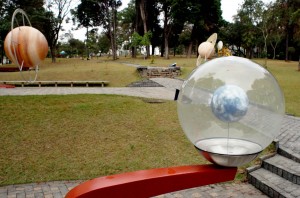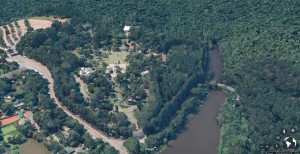Within USP’s area, the greenery of the Atlantic Forest
(by Filipe Albessu Narciso) – May 28th, 2021
The Atlantic Forest, known in Brazil as Mata Atlântica, is one of the most biodiverse biomes in the world. And it is also located at USP’s biggest campus, Cidade Universitária Armando de Salles Oliveira, which preserves more than 360 botanic species in the middle São Paulo city, the most populous city in Brazil. Its presence not only creates an impressive natural landscape, but also enables students and researchers to expand their knowledge about the Atlantic Forest at the same time as it guarantees its protection.

The Brazilian Atlantic Forest once stretched throughout almost the entirety of the country’s 7,500 km coastline, as well as a considerable amount of continental ground. However, as a result of hundreds of years of colonization, urban sprawl and agriculture, it has been deforested as no other tropical ecosystem. For that reason, it is quite impressive to discover that it is still present at the University City Campus of University of São Paulo (USP), located in Brazil’s most populated city.
According to Marcos Buckeridge, postdoctoral researcher and Dean of the Biosciences Institute, the forest patch located in University City is a secondary type of forest, which means that it appeared as a result of reforestation. Before the arrival of the university in 1968, the place where the Campus is located used to be a sugar plantation farm and its surroundings were a rural area. The farm still had some parts of the Atlantic Forest vegetation, which now has a variety of native species in commonplace with invasive species, such as a well-known Australian palm tree.
Considered an international biodiversity hotspot, the Atlantic Forest has a huge quantity of endemic species. The forest’s extent at University City has over 360 varieties of plants and a considerable diversity of birds, reptiles and primates. Most of the forest’s patches are located at the Biosciences Institute, which conducts research on the forest’s animal and botanic life. Buckeridge also mentions that the University City has another kind of vegetation as well, which is similar to the savanna vegetation pattern, known in Brazil as Cerrado.
The professor points out that the place has been subjected to such diversity that it has become more of a unique urban forest kind rather than Atlantic Forest in its pure form. Regarding the research activities and protective actions in the forest, Buckeridge expresses the Biosciences Institute’s profound interest in continuing and expanding these activities and actions. He also mentions a series of projects conducted in the area by the Institute. Among them, the Urban Forest Integration Project has been created to integrate and facilitate research, visitation and teaching at the forest. Uniting the efforts of the Institute to other professionals such as architects and biologists, the project aims to promote biodiversity protection and environmental preservation. He also mentions a complete project, made in a partnership with USP’s Polytechnic School, which scanned the area and made a 3D model of its topology, as you can see in the video here.
To Buckeridge, it is very relevant that the forest is open and accessible to everyone, especially researchers. And by that he means from all of USP’s departments, from medical sciences to humanities related projects, as well as researchers from other universities and research centers as well. “Our idea is that the forest is so well studied that it serves as a model not only for the study of other parts of the Atlantic Forest, but also as a reference for studies on the effects of urban forestation”, said the researcher in an interview in Portuguese.
 There is also another Atlantic Forest conservation site under USP’s care. It is located at the Parque de Ciência e Tecnologia (CienTec), which can be translated as the Science and Technology Park. Also based in the city of São Paulo, only some miles away from the University City, CienTec can be found inside the state park that protects the springs of the Tietê river and that has the largest quantity of protected Atlantic Forest in the capital. Both the state of São Paulo and USP work together to guarantee CienTec’s environmental protection.
There is also another Atlantic Forest conservation site under USP’s care. It is located at the Parque de Ciência e Tecnologia (CienTec), which can be translated as the Science and Technology Park. Also based in the city of São Paulo, only some miles away from the University City, CienTec can be found inside the state park that protects the springs of the Tietê river and that has the largest quantity of protected Atlantic Forest in the capital. Both the state of São Paulo and USP work together to guarantee CienTec’s environmental protection.
CienTec used to be the site of USP’s Institute of Astronomy, Geophysics and Atmospheric Sciences (IAG) until the 1990’s. For that reason, today, the state park where it is located also includes the São Paulo Observatorium and a planetarium. The Zoological Garden and Botanical Garden are also present in the state park. Open to visitation, CienTec possesses more than a thousand acres of Atlantic Forest and has a wide array of possible recreational activities. It is specially engaging for middle and high schoolers, welcoming many school tours under normal circumstances. As a result of the COVID-19 pandemic, the park’s activities have been suspended, but you can still see pictures and educational texts in Portuguese on its website, which can be accessed here.

Flavio Berchez, CienTec’s director and PhD professor, declares that the park used to receive from a hundred to two hundred children visits per day. He mentions that there are physics experiments, foot trails and a lot of environmentally conscious content for children and teenagers. Berchez points out that one of the main focuses of these activities is uniting ludic transdisciplinarity to ethic views regarding the environment.
Additionally, Berchez emphasizes that international cooperation has always been an important aspect of research at the park, mentioning, for example, the exchange of information between USP and the Chilean University of Magallanes. They have a mutual interest in knowledge that involves the Chilean environmental reserve known as Parque Omora, making the exchange enlightening for both institutions.
The forest’s natural resources are a timeless patrimonium, and the maintenance of this natural area is important for USP’s students, the academic community, and the overall society. By committing itself to the preservation of the Atlantic Forest, USP safeguards the specificities of what this rich biome has become today, contributing globally to environmental consciousness and scientific research.
